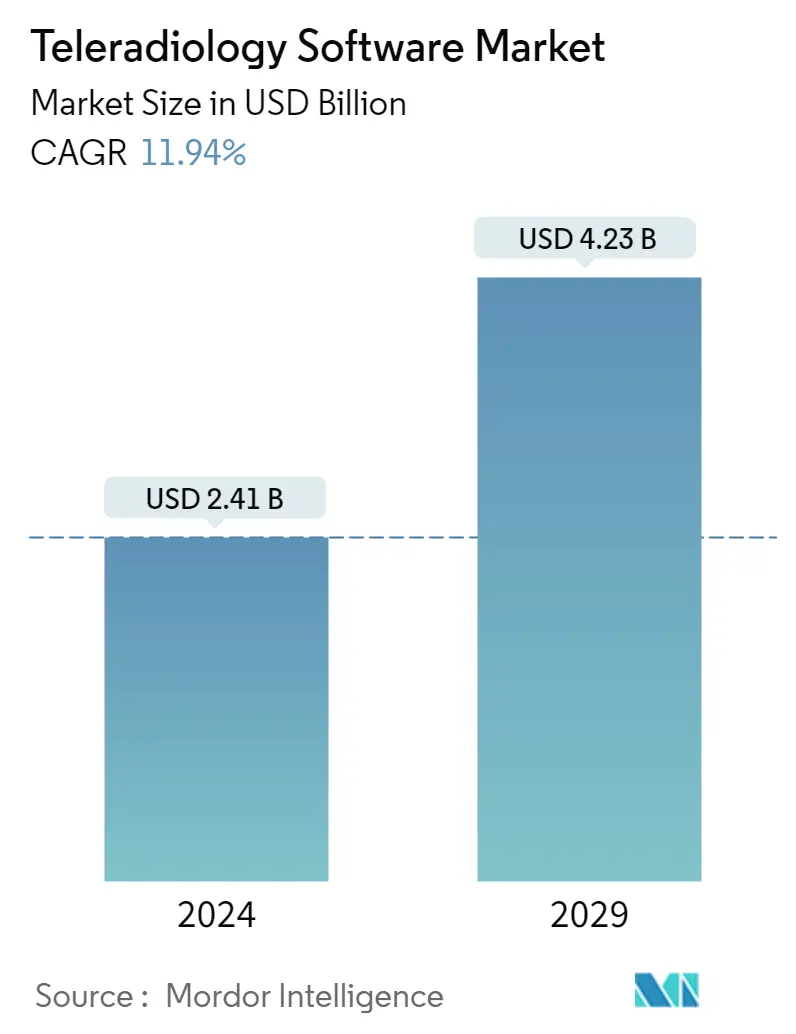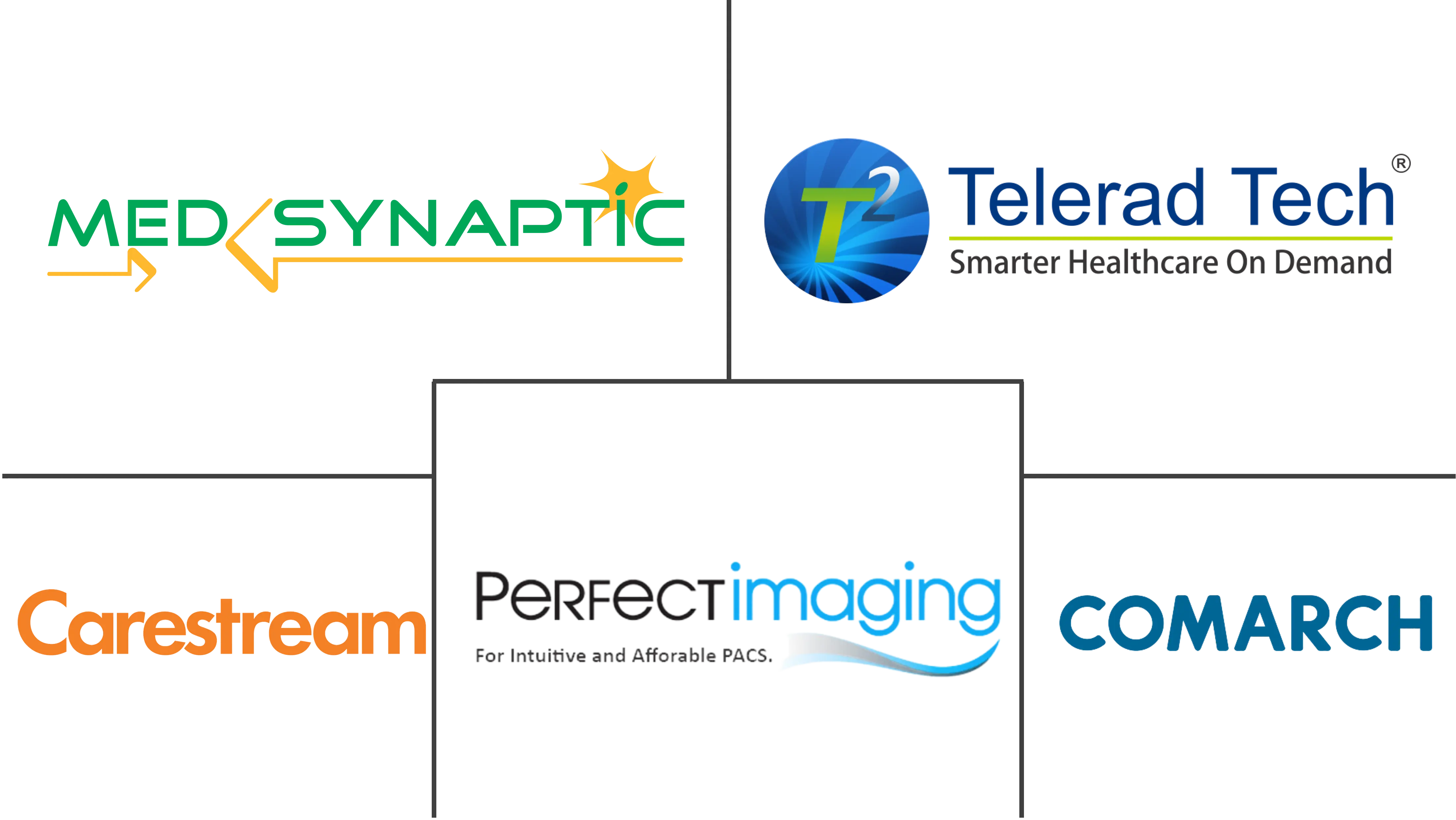Market Size of Teleradiology Software Industry

| Study Period | 2019 - 2029 |
| Market Size (2024) | USD 2.41 Billion |
| Market Size (2029) | USD 4.23 Billion |
| CAGR (2024 - 2029) | 11.94 % |
| Fastest Growing Market | Asia Pacific |
| Largest Market | North America |
Major Players
*Disclaimer: Major Players sorted in no particular order |
Teleradiology Software Market Analysis
The Teleradiology Software Market size is estimated at USD 2.41 billion in 2024, and is expected to reach USD 4.23 billion by 2029, growing at a CAGR of 11.94% during the forecast period (2024-2029).
- The teleradiology software market was significantly impacted by the COVID-19 pandemic, leading to increased adoption of teleradiology software. As per the article published in June 2022 in Oxford Academic, the Government of India implemented teleradiology during the pandemic and launched the CollabDDS Online Radiology Services (CORS) initiative. CORS is a web-based interface that provides an integrated online environment between remote health centers and expert radiologists and doctors in tertiary healthcare facilities to visualize and study radiological images in real time. The pandemic's impact on the teleradiology software market has, therefore, turned out to be positive.
- Currently, the growth of the teleradiology software market is expected to be even better due to the increasing availability of more affordable and faster wireless data transfer, mass storage options, and broadband cellular technology. The major factors driving market expansion include the increasing prevalence of chronic diseases such as cancer, heart disease, bone disorders, and other chronic diseases that require medical imaging and the rise in the adoption of teleradiology across hospitals and clinics.
- For instance, as per the data from the CARES Report 2021, 97.6% of adults and 2.4% of children were reported with out-of-hospital cardiac arrest (OHCA) in 2021 in the United States, and the median age of OHCA is considered to be 64 years. Early diagnosis of risk factors associated with cardiac arrest is being broadly carried out globally to cope with the rising prevalence of cardiac complications, fueling the market growth.
- Moreover, a rise in product launches, technological advancements, and implementation of digital health across hospitals are likely to drive market growth over the forecast period. For instance, in November 2022, Philips introduced new AI-enhanced informatics solutions to increase diagnostic confidence with intelligence at every step of the radiology workflow at RSNA. A new integrated diagnostic approach connects radiology, cardiology, pathology, and oncology to securely unite data and images across the enterprise, enabling earlier and more definitive diagnoses.
- Additionally, in April 2022, Teleradiology Solutions signed an agreement with Andhra Med Tech Zone (AMTZ) to develop a hub in the zone dedicated to offering remote radiology image reads by expert radiologists supported by breakthrough artificial intelligence (AI) solutions to the government and public sectors. This hub will be used to reach out to pan-India government hospitals, state-wide rural health centers (including those funded by the National Health Mission), and public-private partnerships with hospitals where TRS would provide remote radiology services. Thus, such product launches and government collaborations are likely to enhance the utilization of teleradiology software, leading to market growth over the forecast period.
- However, the shortage of skilled radiologists is likely to restrain market growth. Despite the positive impact of the COVID-19 pandemic on the teleradiology software market, this shortage of skilled radiologists may limit the market's growth potential.
Teleradiology Software Industry Segmentation
As per the scope of the report, teleradiology is the transmission of radiological patient images, such as X-rays, CTs, and MRIs, from one site to another for the reason of sharing studies with other radiologists and physicians.
Teleradiology enhances patient care by allowing radiologists to provide services without having to be at the location of the patient. The teleradiology software market is segmented by type (radiology information system, picture archive, communication system, vendor-neutral archive), modality (cloud-based, on-premise), and geography North America, Europe, Asia-Pacific, Middle East and Africa, South America). The report also covers the estimated market sizes and trends for 17 countries across major regions globally.
The report offers the value (in USD) for the above segments.
| By Type | |
| Radiology Information System | |
| Picture Archive and Communication System | |
| Vendor Neutral Archive |
| By Modality | |
| Cloud-Based | |
| On-Premise |
| Geography | ||||||||
| ||||||||
| ||||||||
| ||||||||
| ||||||||
|
Teleradiology Software Market Size Summary
The teleradiology software market is poised for significant growth, driven by the increasing adoption of digital health solutions and advancements in wireless data transfer and storage technologies. The COVID-19 pandemic acted as a catalyst, accelerating the adoption of teleradiology software as healthcare providers sought to maintain continuity of care through remote imaging services. Initiatives like India's CollabDDS Online Radiology Services (CORS) exemplify the positive impact of the pandemic on the market. The rising prevalence of chronic diseases, such as cancer and cardiovascular conditions, necessitates advanced medical imaging solutions, further propelling market expansion. Technological innovations, including AI-enhanced diagnostic tools and integrated health informatics solutions, are expected to enhance diagnostic accuracy and efficiency, contributing to market growth.
The market landscape is characterized by strategic collaborations, product launches, and technological advancements, with key players like Philips and Teleradiology Solutions leading the charge. The PACS segment, integral to teleradiology, is experiencing robust growth due to its application in tumor diagnosis and breast cancer screening, among other areas. North America is anticipated to hold a significant market share, supported by a high prevalence of chronic diseases and the presence of major industry players. However, the market faces challenges, such as a shortage of skilled radiologists, which could potentially hinder growth. Despite these challenges, the competitive landscape remains dynamic, with companies engaging in mergers, acquisitions, and partnerships to enhance their market presence and drive innovation.
Teleradiology Software Market Size - Table of Contents
-
1. MARKET DYNAMICS
-
1.1 Market Overview
-
1.2 Market Drivers
-
1.2.1 Increasing Incidence of Chronic Diseases
-
1.2.2 Rise in Adoption of the Teleradiology Software
-
-
1.3 Market Restraints
-
1.3.1 Shortage of Skilled Radiologists
-
-
1.4 Porter's Five Forces Analysis
-
1.4.1 Threat of New Entrants
-
1.4.2 Bargaining Power of Buyers/Consumers
-
1.4.3 Bargaining Power of Suppliers
-
1.4.4 Threat of Substitute Products
-
1.4.5 Intensity of Competitive Rivalry
-
-
-
2. MARKET SEGMENTATION (Market Size by Value - USD)
-
2.1 By Type
-
2.1.1 Radiology Information System
-
2.1.2 Picture Archive and Communication System
-
2.1.3 Vendor Neutral Archive
-
-
2.2 By Modality
-
2.2.1 Cloud-Based
-
2.2.2 On-Premise
-
-
2.3 Geography
-
2.3.1 North America
-
2.3.1.1 United States
-
2.3.1.2 Canada
-
2.3.1.3 Mexico
-
-
2.3.2 Europe
-
2.3.2.1 Germany
-
2.3.2.2 United Kingdom
-
2.3.2.3 France
-
2.3.2.4 Italy
-
2.3.2.5 Spain
-
2.3.2.6 Rest of Europe
-
-
2.3.3 Asia-Pacific
-
2.3.3.1 China
-
2.3.3.2 Japan
-
2.3.3.3 India
-
2.3.3.4 Australia
-
2.3.3.5 South Korea
-
2.3.3.6 Rest of Asia-Pacific
-
-
2.3.4 Middle East and Africa
-
2.3.4.1 GCC
-
2.3.4.2 South Africa
-
2.3.4.3 Rest of Middle East and Africa
-
-
2.3.5 South America
-
2.3.5.1 Brazil
-
2.3.5.2 Argentina
-
2.3.5.3 Rest of South America
-
-
-
Teleradiology Software Market Size FAQs
How big is the Teleradiology Software Market?
The Teleradiology Software Market size is expected to reach USD 2.41 billion in 2024 and grow at a CAGR of 11.94% to reach USD 4.23 billion by 2029.
What is the current Teleradiology Software Market size?
In 2024, the Teleradiology Software Market size is expected to reach USD 2.41 billion.

